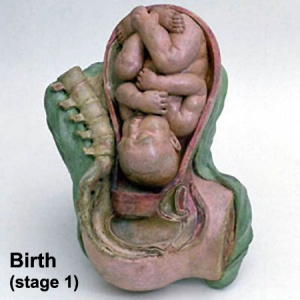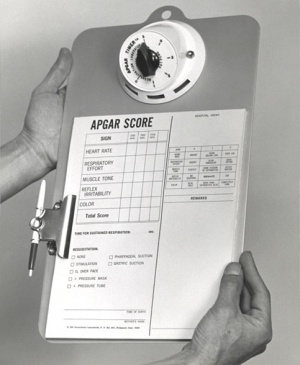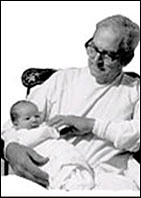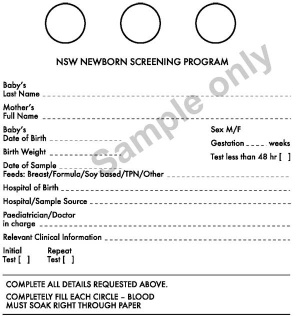2009 Lecture 23: Difference between revisions
(→Heart) |
(→Links) |
||
| Line 143: | Line 143: | ||
==Links== | ==Links== | ||
* '''UNSW Embryology''' [http://embryology.med.unsw.edu.au/Child/birth1.htm Introduction] | [http://embryology.med.unsw.edu.au/Child/birth3.htm Birth Overview] | [http://embryology.med.unsw.edu.au/Child/birth2.htm Abnormalities] | [http://embryology.med.unsw.edu.au/Child/birth6.htm Caesarean] | [http://embryology.med.unsw.edu.au/Child/apgar.htm Apgar] | [http://embryology.med.unsw.edu.au/Child/birthpremature.htm Premature] | [http://embryology.med.unsw.edu.au/Child/birthweight.htm Low Birth Weight] | [http://embryology.med.unsw.edu.au/Child/birth8.htm Placental Cord Clamping] | [http://embryology.med.unsw.edu.au/Child/birthheart.htm Cardiovascular] | [http://embryology.med.unsw.edu.au/Child/birth7.htm Stillbirth and Perinatal Death] | [http://embryology.med.unsw.edu.au/Child/birth10.htm Molecular] [http://embryology.med.unsw.edu.au/Child/birthlink.htm Web Links] | * '''UNSW Embryology''' [http://embryology.med.unsw.edu.au/Child/birth1.htm Introduction] | [http://embryology.med.unsw.edu.au/Child/birth3.htm Birth Overview] | [http://embryology.med.unsw.edu.au/Child/birth2.htm Abnormalities] | [http://embryology.med.unsw.edu.au/Child/birth6.htm Caesarean] | [http://embryology.med.unsw.edu.au/Child/apgar.htm Apgar] | [http://embryology.med.unsw.edu.au/Child/birthpremature.htm Premature] | [http://embryology.med.unsw.edu.au/Child/birthweight.htm Low Birth Weight] | [http://embryology.med.unsw.edu.au/Child/birth8.htm Placental Cord Clamping] | [http://embryology.med.unsw.edu.au/Child/birthheart.htm Cardiovascular] | [http://embryology.med.unsw.edu.au/Child/birth7.htm Stillbirth and Perinatal Death] | [http://embryology.med.unsw.edu.au/Child/birth10.htm Molecular] [http://embryology.med.unsw.edu.au/Child/birthlink.htm Web Links] | ||
* '''Birth Statistics''' [http://embryology.med.unsw.edu.au/Stats/page2.htm Australian Birth Statistics] | [http://embryology.med.unsw.edu.au/Stats/page1.htm International and Australian Population Statistics] | [http://embryology.med.unsw.edu.au/Stats/page3.htm WHO Normal Population Statistics] | [http://www.who.int/inf-fs/en/index_n.html WHO Fact Sheets] | [http://embryology.med.unsw.edu.au/Stats/page3a.htm#perinatal Global Perinatal and Maternal Causes of Death] | [http://embryology.med.unsw.edu.au/Stats/page4a.htm Population Comparisons between Countries] | [http://embryology.med.unsw.edu.au/Stats/page4a.htm#Population%20Data Developed and developing] | [http://embryology.med.unsw.edu.au/Stats/page4a.htm#au1 Australian neighbours] | [http://embryology.med.unsw.edu.au/Stats/page4a.htm#au2 Australian Trading Partners] | |||
== Birth Terms == | == Birth Terms == | ||
Revision as of 11:56, 16 October 2009
Birth and Postnatal Development
Introduction
There are a great number of comprehensive, scientific and general, books and articles that cover Parturition, Birth or Childbirth.
Birth or parturition is a critical stage in development, representing in mammals a transition from direct maternal support of fetal development, physical expulsion and establishment of the newborns own respiratory, circulatory and digestive systems.
Textbooks
- Human Embryology (2nd ed.) Larson Chapter 15 p471-488
- The Developing Human: Clinically Oriented Embryology (6th ed.) Moore and Persaud Chapter 7 p129-167
Gestation Period
The median duration of gestation for first births from assumed ovulation to delivery was 274 days (just over 39 weeks). For multiple births, the median duration of pregnancy was 269 days (38.4 weeks).
- "...one should count back 3 months from the first day of the last menses, then add 15 days for primiparas or 10 days for multiparas, instead of using the common algorithm for Naegele's rule." Reference: Mittendorf R, Williams MA, Berkey CS, Cotter PF. The length of uncomplicated human gestation. Obstet Gynecol. 1990 Jun;75(6):929-32
Historically, Franz Carl Naegele (1777-1851) developed the first scientific rule for estimating length of a pregnany.
Preterm Birth
A study has shown that risks of preterm birth in low abnormal birth weight (intrauterine growth restriction) and high (large for gestational age) categories are 2- to 3-fold greater than the risk among appropriate-for-gestational-age infants.
In another study of placenta previa, low birth weight is due mainly to preterm delivery and to a lesser extent with fetal growth restriction.
Reference: Lackman F, Capewell V, Richardson B, daSilva O, Gagnon R. The risks of spontaneous preterm delivery and perinatal mortality in relation to size at birth according to fetal versus neonatal growth standards. Am J Obstet Gynecol. 2001 Apr;184(5):946-53.
Ananth CV, Demissie K, Smulian JC, Vintzileos AM. Relationship among placenta previa, fetal growth restriction, and preterm delivery: a population-based study. Obstet Gynecol. 2001 Aug;98(2):299-306.
Respiration
- Lungs at birth collapsed and fluid-filled - replaced with air by powerful inspiratory movement and absorption through the alveoli
- Respiratory Rate is higher than adult (30 breaths/minute).
- Rib Orientation - Infant rib is virtually horizontal, allowing diaphragmatic breathing only. Adult rib orientation is oblique (both anterior and lateral views), allows for pump-handle and bucket handle types of inspiration.
Neonatal Testing
APGAR
Measured at one and five minutes after birth the Score values are totalled for all indicators: 7-10 is considered normal, 4-7 may require resuscitative measures, 3 and below require immediate resuscitation.
In recent years there has been some controversy of the relevance and accuracy of some of the criteria used in this test, though many feel it is still an invaluable initial assessment tool particularly where medical services are limited.
| Indicator | Score 0 | Score 1 | Score 2 |
| Activity (muscle tone) | Limp; no movement | Some flexion of arms and legs | Active motion |
| Pulse (heart rate) | No heart rate | Fewer than 100 beats per minute | At least 100 beats per minute |
| Grimace (reflex response) | No response to airways being suctioned | Grimace during suctioning | Grimace and pull away, cough, or sneeze during suctioning |
| Appearance (color) | The baby's whole body is completely bluish-gray or pale | Good color in body with bluish hands or feet | Good color all over |
| Respiration (breathing) | Not breathing | Weak cry; may sound like whimpering, slow or irregular breathing | Good, strong cry; normal rate and effort of breathing |
Reference: Apgar, V. A proposal for a new method of evaluation of the newborn infant. Curr Res Anesth Analg. 1953 Jul-Aug;32(4):260-7. PMID:13083014
Guthrie Test
- Blood is collected using a heelprick and spotted onto a test sheet to dry for later testing.
- Different countries and medical services have different policies on not only what will be diagnostically tested, but also how long the test card will be kept following analysis.
Routine Screened Disorders
- Biotinidase Deficiency (OMIM)
- Congenital Adrenal Hyperplasia (CAH) (OMIM)
- Congenital Hypothyroidism (CH)
- Congenital Toxoplasmosis
- Cystic Fibrosis (CF) (OMIM)
- Galactosemia (GAL) (OMIM)
- Homocystinuria (OMIM)
- Maple Syrup Urine Disease (MSUD) (OMIM)
- Medium-Chain Acyl-CoA Dehydrogenase Deficiency (MCAD) (OMIM)
Heart
- An electrocardiogram (ECG / EKG) is an electrical recording of the heart which may identify electrical disorders including long QT syndrome.
Hip Displasia
- Non-specific hip instability is a common finding in newborns, particularly in females.
- More than 80% of clinically unstable hips at birth resolve spontaneously. Screening newborns for Developmental dysplasia of the hip (DDH) shows an incidence in infants between 1.5 and 20 per 1000 births. This incidence is influenced by several factors (diagnostic criteria, gender, genetic and racial factors, and age of the population).
Links: Musculoskeletal Abnormalities- Congenital Dislocation of the Hip | [hipdyssyn.pdf Screening for Developmental Dysplasia of the Hip PDF] | Screening for developmental dysplasia of the hip. Evidence synthesis no. 42. Rockville, Md.: Agency for Healthcare Research and Quality http://www.ahrq.gov/downloads/pub/prevent/pdfser/hipdyssyn.pdf | U.S. Preventive Service Task Force. Screening for developmental dysplasia of the hip: recommendation statement. Am Fam Physician. 2006 Jun 1;73(11):1992-6.
Hearing
- The incidence of significant permanent hearing loss is approximately 1-3/1000 newborns.
- Neonatal hearing screening is carried out in the USA, UK and in Australia (2002 NSW Statewide Infant Screening Hearing Program, SWISH) There is a general guide giving a timetable for a number of simple responses that a neonate should make if hearing has developed normally.
- State Wide Infant Screening Hearing Program (SWISH) a newborn hearing testing program using an automated auditory response technology (AABR). Program was introduced in NSW Australia in 2002 across 17 area health service coordinators. It is thought that in NSW 86,000 births/year = 86-172 babies potentially born with significant permanent hearing loss.
- Automated Auditory Brainstem Response (AABR) uses a stimulus which is delivered through earphones and detected by scalp electrodes. The test takes between 8 to 20 minutes and has a sensitivity 96-99%.
Abnormalities
Labor Abnormalities
- Premature Labor - occurs 7 -10% in humans, contributes 75% perinatal mortalities
- Underdeveloped Systems - particularly respiratory, surfactant, hyaline membrane disease (see respiratory development lecture)
Placental Abnormalities
- placenta accreta - abnormal adherence, with absence of decidua basalis
- placenta percreta - villi penetrate myometrium
- placenta previa - placenta overlies internal os of uterus, abnormal bleeding, cesarian delivery
Breech Delivery
- Historically, breech-born children were called agrippi, meaning "delivered with difficulty" (aegre parti).
- Breech position - occurs in about 3% of fetuses when buttocks or lower limb are presented to the birth canal rather than normal cephalic (head-first) position (presentation).
- Associated increased - perinatal mortality, perinatal morbidity, recurrence in successive siblings
Current research suggests that genetically that both men and women delivered in breech presentation at term could also contribute to an increased risk of breech delivery in their offspring. ([#18369204 Nordtveit TI, etal., 2008])
Links
- UNSW Embryology Introduction | Birth Overview | Abnormalities | Caesarean | Apgar | Premature | Low Birth Weight | Placental Cord Clamping | Cardiovascular | Stillbirth and Perinatal Death | Molecular Web Links
- Birth Statistics Australian Birth Statistics | International and Australian Population Statistics | WHO Normal Population Statistics | WHO Fact Sheets | Global Perinatal and Maternal Causes of Death | Population Comparisons between Countries | Developed and developing | Australian neighbours | Australian Trading Partners
Birth Terms
amniotomy - birth medical procedure thought to speed labor, where the amniotic sac is artificially ruptured using a tool (amniohook).
breech - fetal buttocks presented first and can also occur in different forms depending on presentation (complete breech, frank breech, footing breech, knee breech).
decidual activation - increased uterine proteolysis and extracellular matrix degradation.
dilatation - opening of the cervix in preparation for birth (expressed in centimetres).
effacement - shortening or thinning of the cervix, in preparation for birth.
forceps - mechanical "plier-like" tool used on fetal head to aid birth.
fetal macrosomia - clinical description for a fetus that is too large, condition increases steadily with advancing gestational age and defined by a variety of birthweights. In pregnant women anywhere between 2 - 15% have birth weights of greater than 4000 grams (4 Kg, 8 lb 13 oz).
membrane rupture - breaking of the amniotic membrane and release of amniotic fluid (water breaking).
morbidity - (Latin, morbidus = "sick" or "unhealthy") refers to a diseased state, disability, or poor health due to any cause.
presentation - how the fetus is situated in the uterus.
presenting part - part of fetus body that is closest to the cervix.
second stage of labour - passage of the baby through the birth canal into the outside world.
Vacuum Extractor - suction cap device used on fetal head to aid birth.
Vertex Presentation (cephalic presentation) where the fetus head is the presenting part, most common and safest birth position.
Glossary Links
- Glossary: A | B | C | D | E | F | G | H | I | J | K | L | M | N | O | P | Q | R | S | T | U | V | W | X | Y | Z | Numbers | Symbols | Term Link
Course Content 2009
Embryology Introduction | Cell Division/Fertilization | Cell Division/Fertilization | Week 1&2 Development | Week 3 Development | Lab 2 | Mesoderm Development | Ectoderm, Early Neural, Neural Crest | Lab 3 | Early Vascular Development | Placenta | Lab 4 | Endoderm, Early Gastrointestinal | Respiratory Development | Lab 5 | Head Development | Neural Crest Development | Lab 6 | Musculoskeletal Development | Limb Development | Lab 7 | Kidney | Genital | Lab 8 | Sensory - Ear | Integumentary | Lab 9 | Sensory - Eye | Endocrine | Lab 10 | Late Vascular Development | Fetal | Lab 11 | Birth, Postnatal | Revision | Lab 12 | Lecture Audio | Course Timetable
Cite this page: Hill, M.A. (2024, April 24) Embryology 2009 Lecture 23. Retrieved from https://embryology.med.unsw.edu.au/embryology/index.php/2009_Lecture_23
- © Dr Mark Hill 2024, UNSW Embryology ISBN: 978 0 7334 2609 4 - UNSW CRICOS Provider Code No. 00098G




